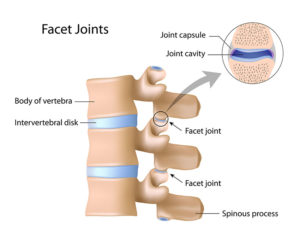Conventional and Not-So-Conventional Facet Joint Pain Management
If you suffer from neck or back pain, you know how severe chronic pain can be. The simplest activities are a challenge, and sometimes the pain can create immobility when it becomes too severe. Spinal pain is particularly complex because of the many muscles that interact with the complex nervous system that runs through the spine. Facet joint pain is one type of spinal pain, which we will discuss below.
Conventional Treatments

Facet joint injuries can be particularly problematic because of their location. The facet joint connects the vertebrae in the spine to help them move. These joints are located on both sides of the spinal cord and even though they are only about the size of a fingernail, they can create severe pain if injured or inflamed.
Facet joint injuries can also be very difficult to diagnose because of their small size and because of their location. Doctors typically use x-rays or MRI to determine specific sites of facet joint injury.
There are surgical procedures available to address many facet joint cases. The discectomy procedure is typically recommended if the facet joints have degraded and damaged an intervertebral disc. During the discectomy, the damaged portion of the disc is removed to alleviate nerve compression on the adjacent nerves. The procedure is often successful at alleviating both pain and numbness as well as restoring some strength. However, it is very invasive and can be expensive as well.

Physicians may also recommend pain killers for facet joint injuries, but most of these come with their own negative side effects, and therefore aren’t ideal for treating the situation.
Unconventional Treatments
Before the pain becomes chronic, more conservative treatments are effective. New minimally invasive procedures like injections and ablation can help treat facet joint pain and are ideal because they don’t require a hospital stay; instead they can be performed as an outpatient procedure.
Typical treatments include injections of both anesthetic and steroids into the joint to promote healing. These injections are very difficult and require great skill and experience because the specialist must locate the specific facet joint with pinpoint precision. Several injections over a period of days or weeks are needed, so several office visits are required. The injections might be sufficient to relieve pain; if not, the goal of the injections is to achieve enough pain relief so that the patient can proceed with physical therapy. Results depend on the degree of injury, the severity of inflammation, and the effectiveness of physiotherapy.
For some patients, even a series of repeated injections is not enough to alleviate pain. In these cases, the doctor may recommend a cervical radiofrequency ablation (RFA). When an RFA is done, radiofrequency energy uses heat to literally burn and thus destroy specific nerves to stop those nerves from transmitting pain signals from the spine to the brain. Cervical pain is alleviated for some patients following a RFA treatment, but nerves can and often do regenerate, and further RFA procedures are required. In other words, an RFA procedure is not a sure thing.

Physical therapy can also offer pain relief because it strengthens the core muscles that surround the facet joints. Physical therapy can also stretch muscles, thereby decompressing nerves, which significantly reduces pain. Having strength in the area can prevent or slow down further joint degradation, so it is a good non-invasive treatment option that works for many patients.
Chiropractic spinal alignments can also relieve facet syndrome, but not all patients will be candidates depending on the extent and location of the facet joint injury. Acupuncture has also been effective for patients, with many around the world claiming facet joint pain relief. The placement of the tiny needles is believed to stimulate the surrounding nerves and muscles and increase circulation to the area, thus relieving the symptoms.
Chiropractic care and physical therapy are both designed to relieve pain and partially restore flexibility to the spine, but the treatments are not designed to address the cause of the pain. H-Wave electrical stimulation is also a non-invasive alternative treatment intended to speed recovery, restore function, and manage chronic pain. Rather than masking the pain like other electrotherapy modalities such as TENS, H Wave is a rehabilitative device that addresses the root cause of pain.
As always, rest is a good remedy. After all, rest relaxes the spine which in turn reduces inflammation in the facet joints, and that relieves pain, so it is a win-win-win option.